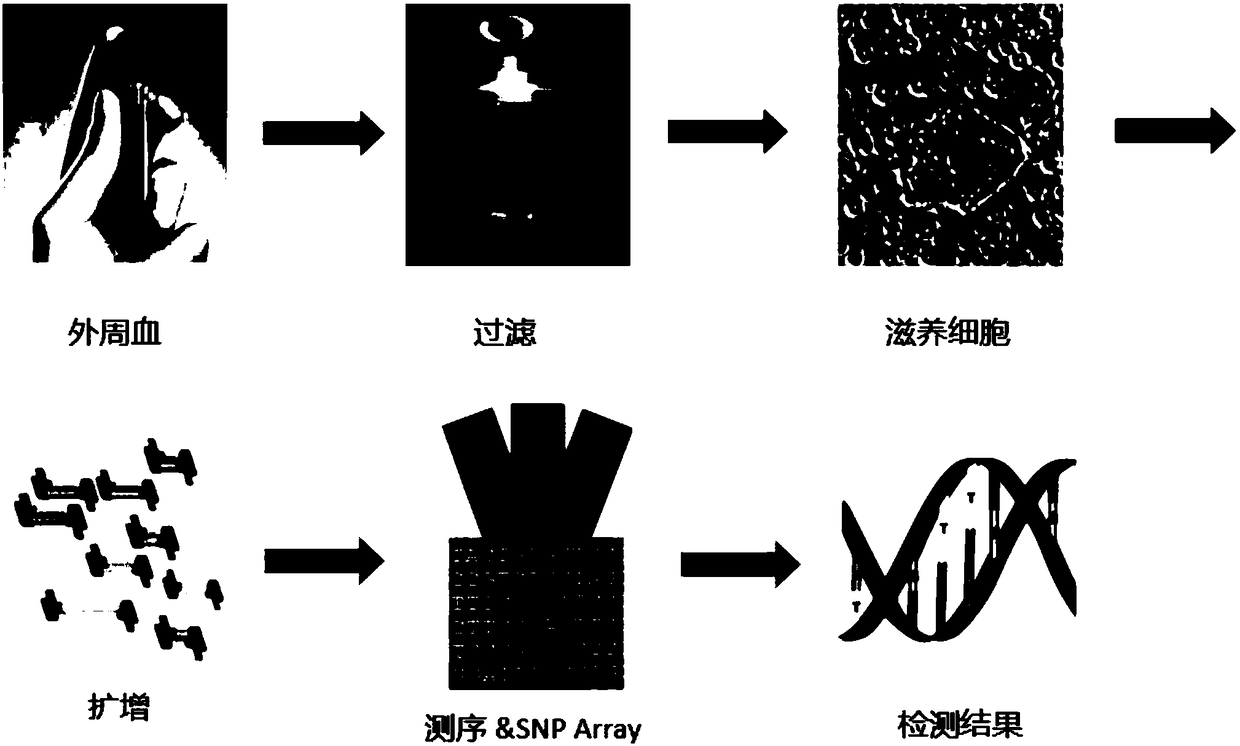Fetal trophoblast cell separation method and application
A technology of trophoblasts and fetuses, applied in the medical field, can solve the problems of cumbersome steps, lack of economical practicability, uneconomical, etc., and achieve the effect of extensive clinical promotion value, extensive economical practicability, and simple cost
- Summary
- Abstract
- Description
- Claims
- Application Information
AI Technical Summary
Problems solved by technology
Method used
Image
Examples
Embodiment 1
[0039] Example 1 Analysis of Genomic DNA
[0040] 1) Isolation of fetal trophoblast cells from maternal peripheral blood
[0041] Take 1-20ml of peripheral venous blood from pregnant women at 5-38 weeks of pregnancy, preferably at 8-15 weeks of pregnancy, the optimal blood collection volume is 10ml, and collect 10ml of blood into EDTA anticoagulant tubes (product number: 366643, BD); Within 1 hour, add 10ml of blood to Proprietary Buffer (Rarecells) and dilute it at 1:10. This Buffer can lyse red blood cells and fix nucleated cells; S1014) or filter with Chemrus disposable filter funnel (Chemrus, product number: CR-1008-300, 40μm) to remove non-trophoblast cells; if there are still other cells under the microscope, such as lymphocytes, granulocytes, etc., the filter can be repeated many times, Until pure maternal peripheral blood fetal trophoblasts are obtained;
[0042] 2), cell lysis and DNA amplification
[0043] After collecting a single fetal cell or a small number of ...
Embodiment 2
[0048] Example 2 Analysis of RNA expression
[0049] 1) Isolation of fetal trophoblast cells from maternal peripheral blood
[0050]Take 1-20ml of peripheral venous blood from pregnant women at 5-38 weeks of pregnancy, preferably at 8-15 weeks of pregnancy, the optimal blood volume is 10ml, and collect 10ml of blood into EDTA anticoagulant tubes (product number: 366643, BD). Within 4 hours of blood collection, add 10ml of blood to Proprietary Buffer (Rarecells) and dilute it at 1:10. This Buffer can lyse red blood cells and fix nucleated cells. After 10 minutes, the blood sample was filtered through a filter device with a pore size of 35 μm (Molecular Biotechnology, product number: S1014) or a Chemrus disposable filter funnel (Chemrus, product number: CR-1008-300, 40 μm) to remove non-trophic cells. If there are still other cells under the microscope, such as lymphocytes, granulocytes, etc., the filtration can be repeated many times until pure maternal peripheral blood fetal ...
Embodiment 3
[0055] Example 3 Analysis of DNA methylation
[0056] 1) Isolation of fetal trophoblast cells from maternal peripheral blood
[0057] Take 1-20ml of peripheral venous blood from pregnant women at 5-38 weeks of pregnancy, preferably at 8-15 weeks of pregnancy, the optimal blood volume is 10ml, and collect 10ml of blood into EDTA anticoagulant tubes (product number: 366643, BD). Within 4 hours of blood collection, add 10ml of blood to Proprietary Buffer (Rarecells) and dilute it at 1:10. This Buffer can lyse red blood cells and fix nucleated cells. After 10 minutes, pass the blood sample through a filter device with a filter aperture of 35 μm (Molecular Biotechnology, product number: S1014) or filter it with a Chemrus disposable filter funnel (Chemrus, product number: CR-1008-300, 40 μm) to remove non-trophic cells. There are still other cells under the microscope, such as lymphocytes, granulocytes, etc., which can be repeatedly filtered until pure maternal peripheral blood fet...
PUM
| Property | Measurement | Unit |
|---|---|---|
| pore size | aaaaa | aaaaa |
Abstract
Description
Claims
Application Information
 Login to View More
Login to View More - R&D
- Intellectual Property
- Life Sciences
- Materials
- Tech Scout
- Unparalleled Data Quality
- Higher Quality Content
- 60% Fewer Hallucinations
Browse by: Latest US Patents, China's latest patents, Technical Efficacy Thesaurus, Application Domain, Technology Topic, Popular Technical Reports.
© 2025 PatSnap. All rights reserved.Legal|Privacy policy|Modern Slavery Act Transparency Statement|Sitemap|About US| Contact US: help@patsnap.com

